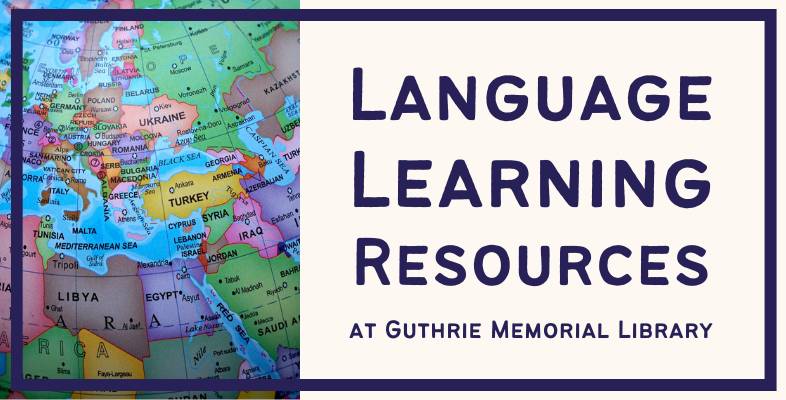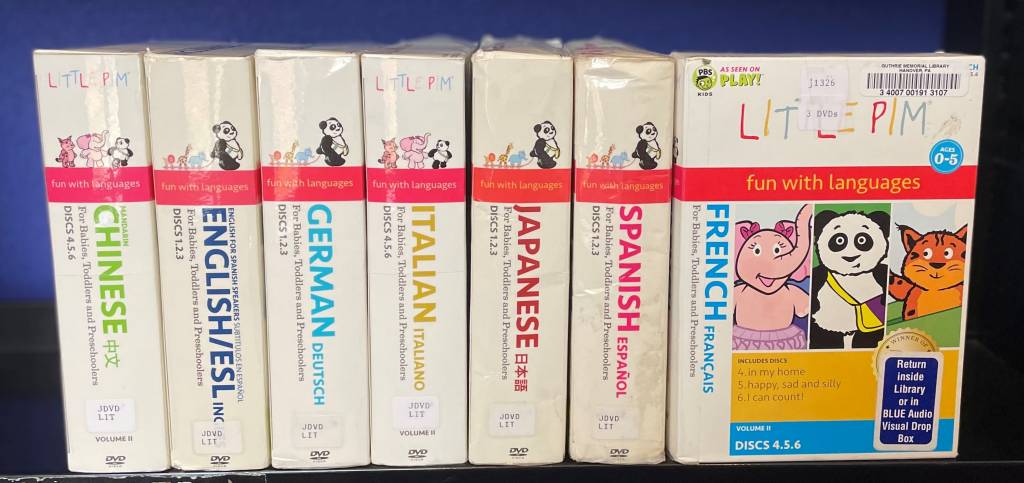
In an increasingly connected world, there are more advantages than ever to studying a new language. With technological increases it has also never been easier to learn one while stuck in traffic or attending to chores at home. The Guthrie Memorial Library has numerous resources to help our patrons in their quest to learn a new language, no matter the level of intended proficiency. But first, it might help to understand some of the science behind how we learn language. It also may help to understand the advantages of speaking more than one language. That way, in understanding both, you can better define your goals.
The Advantages of Learning a New Language
Did you know that 13% of the US population speak Spanish at home? Businesses need to keep up in advertising to and satisfying the demands of this demographic. Spanish proficiency is also a valuable asset to have on a resume, and there are numerous advantages to being able to list other languages on one’s resume, even if just to differentiate oneself from the pool of other applicants. Beyond the obvious advantages of speaking more than one language there are also profound neurological advantages that spill over into other areas of thought and life, as this quote from the Washington Post makes clear:
“The first main advantage involves what’s loosely referred to as executive function. This describes skills that allow you to control, direct and manage your attention, as well as your ability to plan. It also helps you ignore irrelevant information and focus on what’s important. Because a bilingual person has mastery of two languages, and the languages are activated automatically and subconsciously, the person is constantly managing the interference of the languages so that she or he doesn’t say the wrong word in the wrong language at the wrong time.”
Even if your interest is simply to be able to order a glass of Chianti and a plate of pasta in Rome in Italian it’s best to know how to approach learning. Any well-designed home course would work on production and comprehension. Comprehension consists of both aural and written understanding, and production essentially means being able to speak or write. Therefore, any home course must include practicing all of these abilities.
One of the very best tools to practice aural comprehension and speaking is the Pimsleur Language Program. Each half hour lesson consists of listening and repeating a series of increasingly complex but everyday phrases. You can complete the lessons on the go, whether in your car or through your headphones at the track. The programs come in a broad variety of languages, such as the introductory Latin American Spanish course here.
A person seriously committed to learning to conversational proficiency should use a dictionary, grammar guide, and a text and workbook. Thankfully a whole array of these materials is available in between 428-495 in the non-fiction section. Lastly, film can be a useful tool not only for advanced learners to further their comprehension but also deepen their cultural appreciation. Ask a librarian for help in finding films in your target language.
Language Learning in the Children’s Department

There are profound advantages to starting your child early on learning a second language. The science is clear: the sooner your child starts learning a language the more proficient they will be as an adult. And in an increasingly globalized world our children are likelier than ever to need bilingual abilities.
Pimsleur created a junior program that teaches children in much the same way as their adult program, but they focus on fun topics, like family or food. The Children’s Department carries numerous Little Pim language choices, including Introductory Spanish, French, Japanese, and more. Books that reinforce language-learning for kids, such as My First Spanish Phrases, are also available in the Children’s Department.
The Children’s Department is also a great place to start for adult beginners, no matter what language you are learning.
Resources for English Learners
Additionally, the library has numerous resources for the English Language Learner. Pimsleur also offers a course for the ESL learner, which can be found here. There are several grammar guides, dictionaries, and textbooks for the ESL learner in the non-fiction setting, but some of the best resources for the English learner can be found in the Children’s Department. For example, book media such as books with CD allow English learners to read along as they practice their aural comprehension, such as in this Truman Capote Christmas classic. Books on CD are also a valuable resource, because of the relaxed nature of the storytelling and the diversity of scenarios. The Children’s Department’s books also serve as learning resources, because the English learner can choose to engage with texts that correspond to their particular language level.
We would recommend that any learner come in and take a look at the books and choose the level with which they feel the most comfort. Beginners would find the picture book section an easy way to begin reading and understanding English. Intermediate learners can move on to our Easy Reader and Easy Chapter sections to enhance their grammar and vocabulary, and more advanced learners can move on to our fiction and non-fiction sections. Lastly, the most valuable resource for a language learner is the contact of a class where they can interact with others and practice. Most Saturdays here at Guthrie the Hanover Diversity Alliance offers a Free ESL Course. You can check it out here.
Online Resources
With your library card you gain access to the Rocket Languages Application, featuring such diverse languages as ASL (American Sign Language), Hindi, ESL, Arabic, and Korean. This diversity is one of the advantages of this free online resource because accessing some of these other languages can be difficult without spending a large amount of money or using InterLibrary Loan. This application covers primarily generic and beginner concepts, but would serve as a firm basis for moving on to deeper language competency.
The Fable Cottage is a wonderful resource for the more comfortable or advanced learner prepared to read a series of short stories and fables in English, Spanish, German, Italian, French, and Russian. Much like the aforementioned books from the Children’s Department as a resource for English-learners, these texts deepen a language learner’s understanding and facility with these languages. This is also a free resource for library members.
Stay in the Know!
Check out our August Newsletter.
Take a look at our Events Calendar and fill your summer schedule.
Follow us on Facebook and stay up to date on the latest news.
Let your voice be heard! What do you want to see the library blog cover next? Submit a request here.
